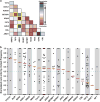Age-related mutations and chronic myelomonocytic leukemia
- PMID: 26648538
- PMCID: PMC5096889
- DOI: 10.1038/leu.2015.337
Age-related mutations and chronic myelomonocytic leukemia
Abstract
Chronic myelomonocytic leukemia (CMML) is a hematologic malignancy nearly confined to the elderly. Previous studies to determine incidence and prognostic significance of somatic mutations in CMML have relied on candidate gene sequencing, although an unbiased mutational search has not been conducted. As many of the genes commonly mutated in CMML were recently associated with age-related clonal hematopoiesis (ARCH) and aged hematopoiesis is characterized by a myelomonocytic differentiation bias, we hypothesized that CMML and aged hematopoiesis may be closely related. We initially established the somatic mutation landscape of CMML by whole exome sequencing followed by gene-targeted validation. Genes mutated in ⩾10% of patients were SRSF2, TET2, ASXL1, RUNX1, SETBP1, KRAS, EZH2, CBL and NRAS, as well as the novel CMML genes FAT4, ARIH1, DNAH2 and CSMD1. Most CMML patients (71%) had mutations in ⩾2 ARCH genes and 52% had ⩾7 mutations overall. Higher mutation burden was associated with shorter survival. Age-adjusted population incidence and reported ARCH mutation rates are consistent with a model in which clinical CMML ensues when a sufficient number of stochastically acquired age-related mutations has accumulated, suggesting that CMML represents the leukemic conversion of the myelomonocytic-lineage-biased aged hematopoietic system.
Conflict of interest statement
CCM and MWD report a potential related conflict of interest of research funding from Agilent Technologies, Inc. MWD also reports a potential related conflict of interest of research funding from Celgene, Inc. All other authors declare no conflict of interests.
Figures




Similar articles
-
Clinical significance of CSF3R, SRSF2 and SETBP1 mutations in chronic neutrophilic leukemia and chronic myelomonocytic leukemia.Oncotarget. 2017 Mar 28;8(13):20834-20841. doi: 10.18632/oncotarget.15355. Oncotarget. 2017. PMID: 28209919 Free PMC article.
-
Clonal dynamics of chronic myelomonocytic leukemia progression: paired-sample comparison.J Pathol. 2025 Apr;265(4):437-447. doi: 10.1002/path.6396. Epub 2025 Feb 5. J Pathol. 2025. PMID: 39905935
-
SRSF2 mutations in 275 cases with chronic myelomonocytic leukemia (CMML).Blood. 2012 Oct 11;120(15):3080-8. doi: 10.1182/blood-2012-01-404863. Epub 2012 Aug 23. Blood. 2012. PMID: 22919025 Free PMC article.
-
Genetic and epigenetic factors interacting with clonal hematopoiesis resulting in chronic myelomonocytic leukemia.Curr Opin Hematol. 2020 Jan;27(1):2-10. doi: 10.1097/MOH.0000000000000553. Curr Opin Hematol. 2020. PMID: 31688455 Review.
-
When clinical heterogeneity exceeds genetic heterogeneity: thinking outside the genomic box in chronic myelomonocytic leukemia.Blood. 2016 Nov 17;128(20):2381-2387. doi: 10.1182/blood-2016-07-692988. Epub 2016 Oct 5. Blood. 2016. PMID: 27707735 Review.
Cited by
-
Genetic architecture of the acute and persistent immune cell response after radiation exposure.Cell Genom. 2023 Oct 6;3(11):100422. doi: 10.1016/j.xgen.2023.100422. eCollection 2023 Nov 8. Cell Genom. 2023. PMID: 38020972 Free PMC article.
-
Macrophage migration inhibitory factor is overproduced through EGR1 in TET2low resting monocytes.Commun Biol. 2022 Feb 3;5(1):110. doi: 10.1038/s42003-022-03057-w. Commun Biol. 2022. PMID: 35115654 Free PMC article.
-
Comprehensive mutation profiling and mRNA expression analysis in atypical chronic myeloid leukemia in comparison with chronic myelomonocytic leukemia.Cancer Med. 2019 Feb;8(2):742-750. doi: 10.1002/cam4.1946. Epub 2019 Jan 11. Cancer Med. 2019. PMID: 30635983 Free PMC article.
-
Emerging molecular subtypes and therapeutic targets in B-cell precursor acute lymphoblastic leukemia.Front Med. 2021 Jun;15(3):347-371. doi: 10.1007/s11684-020-0821-6. Epub 2021 Jan 5. Front Med. 2021. PMID: 33400146 Review.
-
Loss of RAF kinase inhibitor protein is involved in myelomonocytic differentiation and aggravates RAS-driven myeloid leukemogenesis.Haematologica. 2020 Jan 31;105(2):375-386. doi: 10.3324/haematol.2018.209650. Print 2020. Haematologica. 2020. PMID: 31097632 Free PMC article.
References
-
- Patnaik MM, Padron E, LaBorde RR, Lasho TL, Finke CM, Hanson CA, et al. Mayo prognostic model for WHO-defined chronic myelomonocytic leukemia: ASXL1 and spliceosome component mutations and outcomes. Leukemia. 2013;27:1504–1510. - PubMed
-
- Williamson PJ, Kruger AR, Reynolds PJ, Hamblin TJ, Oscier DG. Establishing the incidence of myelodysplastic syndrome. Br J Haematol. 1994;87:743–745. - PubMed
-
- Aul C, Gattermann N, Schneider W. Age-related incidence and other epidemiological aspects of myelodysplastic syndromes. Br J Haematol. 1992;82:358–367. - PubMed
-
- Tyner JW, Loriaux MM, Erickson H, Eide CA, Deininger J, MacPartlin M, et al. High-throughput mutational screen of the tyrosine kinome in chronic myelomonocytic leukemia. Leukemia. 2009;23:406–409. - PubMed
-
- Gelsi-Boyer V, Trouplin V, Roquain J, Adélaïde J, Carbuccia N, Esterni B, et al. ASXL1 mutation is associated with poor prognosis and acute transformation in chronic myelomonocytic leukaemia. Br J Haematol. 2010;151:365–375. - PubMed
Publication types
MeSH terms
Substances
Grants and funding
- CA04963920/CA/NCI NIH HHS/United States
- P01CA049639/CA/NCI NIH HHS/United States
- 1R01CA178397-01/CA/NCI NIH HHS/United States
- 1R01CA183974-01/CA/NCI NIH HHS/United States
- R01 CA183974/CA/NCI NIH HHS/United States
- R00 CA151457/CA/NCI NIH HHS/United States
- 5R00CA151457-04/CA/NCI NIH HHS/United States
- R01 CA178397/CA/NCI NIH HHS/United States
- R01 GM104390/GM/NIGMS NIH HHS/United States
- P01 CA049639/CA/NCI NIH HHS/United States
- T32 GM007464/GM/NIGMS NIH HHS/United States
- P30 CA042014/CA/NCI NIH HHS/United States
- K08 HL111280/HL/NHLBI NIH HHS/United States
LinkOut - more resources
Full Text Sources
Other Literature Sources
Molecular Biology Databases
Research Materials
Miscellaneous

